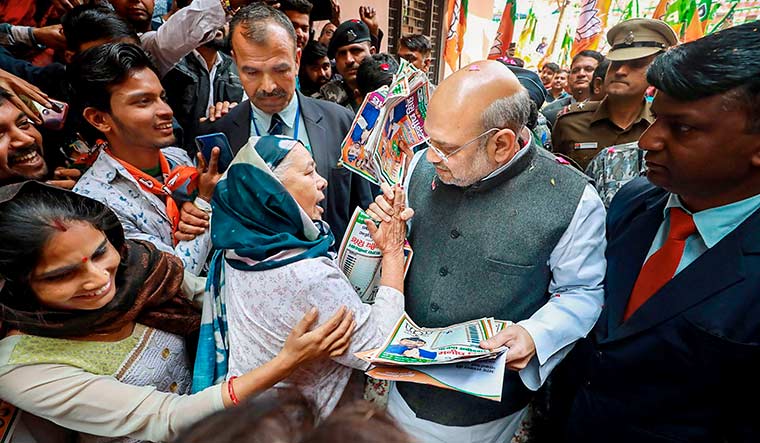HOME MINISTER AMIT Shah, self confessedly, does not ruminate over losses. Back in 2015, a few months into his tenure as party president, the BJP lost the Delhi and Bihar state elections. Lessons learnt, the party changed tack and subsequently won several other states.
Delhi, however, remained elusive.
On January 22, two days after passing the baton of party president to J.P. Nadda, Shah dove headlong into electoral battle. He went micro, asking his party leaders to form small teams, go to households, and hold street-side meetings and roadshows. Shah himself hit the road, addressing three meetings every evening. Additionally, all party chief ministers, former chief ministers and even those from allied parties have been roped in to carpet bomb the state. In a final push, the leadership told 375 parliamentarians to visit Delhi slums for six hours, for four days. This has been the BJP’s most intense Delhi campaign ever, and even rival parties believe the party’s campaign has picked up with Shah taking control.
“Give us a mandate to end the Shaheen Bagh protest,” Shah says meeting after meeting, to counter the rising sentiment against the new citizenship law. A win in Delhi will only embolden the government to crack down on the protesters, as it can claim that the result shows that the people support the CAA.
Shah’s tenure as BJP president will be remembered for the way electoral politics changed in the country. An example would be how he reacted as the state election results for Uttar Pradesh, Goa and Manipur came in on March 11, 2017. Though he was getting congratulatory calls on the party’s stunning performance in Uttar Pradesh, Shah was worried about Manipur and Goa, where the Congress had got more seats. He asked Piyush Goyal and Nitin Gadkari to drop everything and go to Manipur and Goa. Time was crucial and, as subsequent events proved, the BJP was ahead of the curve; it formed the government in these states.
In his time, Shah brought alacrity and secrecy to his decision making. For instance, no one expected the choice of Yogi Adityanath as Uttar Pradesh chief minister. Adityanath had impressed Shah when the latter was made BJP general secretary in-charge of the state in 2013.
Shah’s decision-making aside, his greater contribution to the BJP was changing its profile and strengthening its ideological grain. “It is difficult for a party to launch struggles while it is in power. But the way Amit Shah expanded the party is unique,” Prime Minister Modi had once said.
During the Atal Bihari Vajpayee era, for instance, the organisation had taken a back seat as most leaders were absorbed into the government. But when Modi took over, a lakshman rekha was maintained between the party and the government.
It was during the BJP’s national executive meeting in April 2015, in Bengaluru, that Shah unveiled his vision to expand the party by building permanent offices in more than 650 districts. The vision culminated in the BJP building a state-of-the-art headquarters at Deen Dayal Upadhyaya Marg in Delhi.
Under Shah, the BJP enrolled over 11 crore new members, making it the largest political party in the world.
Shah was always for building institutions, said a source. During his initial days as general secretary in-charge of Uttar Pradesh, Shah noticed an anomaly in the laundry bill at the state office. It was huge. “There are more pyjamas being given for laundry than there are people in the office,” Shah apparently remarked. The leaders were getting their clothes washed at the party’s expense. Shah immediately put a stop to it.
As for the ideological edge, the BJP found it in 2016, after some Jawaharlal Nehru University students allegedly chanted separatist slogans on campus. The party brought nationalism into its campaign, and the mix of hindutva and development helped it build a national narrative.
Said a BJP leader: “A template has been set for elections. The party just needs to follow it in terms of putting effort.”
As the BJP begins its new journey under Nadda, it will look to achieve its remaining goals—win West Bengal, Delhi and Kerala. Said BJP general secretary Anil Jain: “We are confident that the party that scaled new heights under Modi and Shah will move forward under Nadda and become organisationally stronger.”


